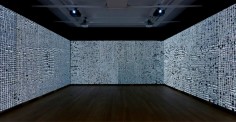JURRIAAN SCHROFER AND LUST
type/dynamics
source: designboom
the exhibition type/dynamics: jurriaan schrofer/lust sees two galleries at the stedelijk museum adorned with large, innovative typographic installations. gallery 0.29 contains a selection of the work by graphic designer jurriaan schrofer. the second gallery, 0.28, features an interactive work by lust, who were asked to use cutting-edge media to create an installation that plays off, reacts to, and dialogues with schrofer’s work. the visual dynamic of schrofer’s typographic art suggests that his designs were created on the computer but they predate the digital era: schrofer designed everything by hand. for LUST, though, the computer is an indispensable tool; they derive inspiration from exploring the possibilities of design for new media and technologies.
.
.
.
.
.
.
.
source: creativeapplicationsnet
Created by the the Dutch design studio LUST, ‘Type/Dynamics’ is a new interactive installation for the exhibition of work by the graphic designer Jurriaan Schrofer (1926-1990) at the Stedelijk Museum in Amsterdam. This installation, that utilises eight HD projectors combined with Kinect sensors to transcribe data into typography, interprets and comments on the work in an effort to revitalise recent design history.
The installation visualises information that continuously surrounds us and is always accessible. By searching for real-time locations currently in the news, like “Ground Zero”, “Reichstag”, or “Tiananmen Square”, the installation can locate the panorama images from Google Street View, abstract them into grids and fill the grids with new information. As a visitor to the space, you are ‘transported’ to that location and surrounded by all the news associated with that specific location. Instead of a photographic representation, the place is represented purely typographically with a host of new items currently being talked about at that location. Nothing in the gallery space stands still; all information is dynamic.
001.SM-J.SCHROFER+LUST.Z.029en028.NOV.2013-Ph.GJ.vanROOIJ005.SM-J.SCHROFER+LUST.Z.029en028.NOV.2013-Ph.GJ.vanROOIJ
Stedelijk Museum Amsterdam, photo Gert-Jan van Rooij
Jurriaan Schrofer looked for new ways to express dynamics and movement in printed typography. ‘Type/Dynamics’ shows the dynamic qualities of information and typography. The concept that design is endowed with a form that is unfinished or changeable has been self-evident in contemporary design for quite some time. Nowadays attention is paid more to the design of rules, or creating the framework in which something can happen. In a database for instance, content does not have an innate form, but rather receives form at the moment it is shown via the interface. In fact, the same information can be represented in an endless number of ways. The interface allows for content to be shown as data, as information, or as knowledge; ultimately content appears as loose data without a context, as data in a context, or as interpreted information. This data can even change per week, day, or minute. What is evident through this process is a very different approach and attitude towards desi
gn than the questions of Schrofer’s generation.
008.SM-J.SCHROFER+LUST.Z.029en028.NOV.2013-Ph.GJ.vanROOIJ006.SM-J.SCHROFER+LUST.Z.029en028.NOV.2013-Ph.GJ.vanROOIJ004.SM-J.SCHROFER+LUST.Z.029en028.NOV.2013-Ph.GJ.vanROOIJ
Jurriaan Schrofer room at Type/Dynamics exhibition, Stedelijk Museum Amsterdam, photo Gert-Jan van Rooij
The exhibition consists of two identical galleries of the same conceptual theme. In the first gallery the walls are covered with enlarged detail images of Schrofer’s work. Originals are located in vitrines with an emphasis on sketches. The second gallery presents LUST’s free interpretation of Schrofer’s work. Sensors track the visitors’ movement, while the projections subsequently respond to the position and number of visitors in the space, as well as their distance from the gallery walls.
The installation software runs on a custom built computer powered with a quad core i7 CPU, 16GB ram and two ATI 7880 eyefinity adapters that drive eight HD projectors. The software was written in Java on top of RNDR, LUST’s in-house framework for creative coding.The tracking setup consists of four small (Intel NUC DC53427HY) computers, each of which is connected to two Kinect sensors. The data that is acquired from the Kinect sensors is sent to a processing unit that fuses the data into a single observation of the space. Using this setup they accurately track multiple individuals through the entire space at responsive rates.
.
.
.
.
.
.
.
source: hypeandhyper
A holland design stúdió, a LUST új installációja – mely az amszterdami Stedelijk Múzeum ’Type/Dynamics’ című kiállításán látható március 4-ig – a minket folyamatosan körülvevő és bárki által bármikor elérhető információkat jeleníti meg. A LUST célja az installáció megalkotásával az volt, hogy kifejezzék, a tipográfia napjainkban – amikor az adat ezerféle formában és módon elérhető – önmagában is lehet a tartalom hordozója. Mert bár egy betű a legkisebb tartalomegység, mégis önmagában képes egy teljes adatsor megjelenítésére.
A kiállítás látogatói egy adott helyszínre rákeresve (pl. Tienanmen Tér, Ground Zero) annak szereplőivé válhatnak, körülvéve magukat az ahhoz kapcsolódó összes hírrel. A kiállítás rendhagyó módon képek helyett a tipográfiai eszközeivel mutat be mindent, segítségül hívva az adott helyszínhez aktuálisan kapcsolódó internetes forrásokat. Így válik a kiállítótér egy folyamatosan változó, interaktív helyszínné – bizonyítva az információáramlás dinamikusságát.
Az installáció egyékbént Jurriaan Schrofer (1926-1990) grafikus munkájával interakcióban és arra relfektálva került megalkotásra. A Type/Dynamics kiállítás így maga is két különálló kiállítótérből áll: az első térben Schrofer munkái kerültek kiállításra (eredetiek és felnagyított részletek), részben a falakon, illetve vitrinekben, részben pedig két vertikális képernyőn kivetítve, ahol a vetített kép interaktív kapcsolatban van a látogatók aktuális pozíciójával.
A második térben helyezték el a LUST stúdió munkáját, ahol az érzékelők folyamatosan követik a látogatók mozgását, a kivetített kép pedig mindig a látogatók számának, pozíciójának és a faltól való távolságának függvényében változik. Ha pedig a látogatót egy adott témáról többet szeretne tudni, csak közelítenie kell a fal felé, és máris további információhoz juthat az adott hírrel, helyszínnel kapcsolatban.


